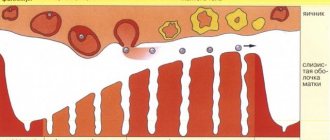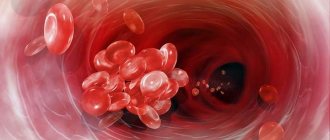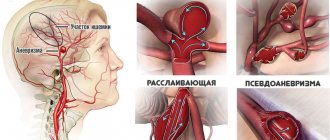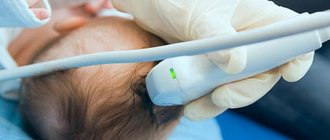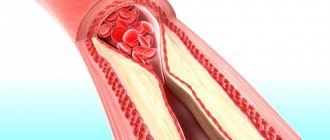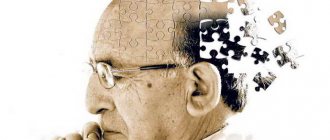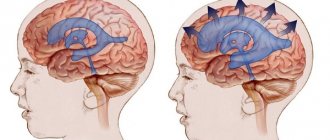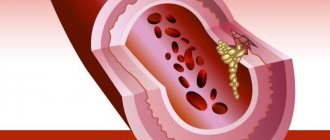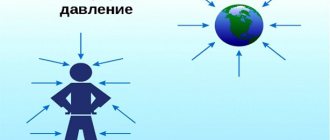Many people have come across the concept of “intracranial pressure”. But not many people know what it is. Intracranial pressure occurs as a result of an increase in the volume of fluid that “washes” the brain (CSF). An increase in the amount of secreted cerebrospinal fluid can occur as a result of the following factors: head injury, brain diseases (meningitis, encephalitis, brain tumors), oxygen starvation of the brain, impaired outflow of venous blood from the skull, congenital diseases of the central nervous system, poisoning (food, chemical, medicinal) ).
The performance of the brain, as well as the well-being of a person as a whole, directly depends on the normal circulation of cerebrospinal fluid. With increased intracranial pressure, the brain cannot function normally. In addition to unpleasant sensations, this condition is fraught with atrophy of the brain substance; in other words, the brain slowly begins to die. Therefore, when the first symptoms of increased intracranial pressure appear, you must consult a doctor for an examination and prescribe the necessary and surgical treatment.
Why does ICP increase?
Experts identify several pathologies that increase intracranial pressure. These include:
- Neoplasms in the brain.
- Inflammation of the meninges.
- Blockage of venous sinuses by blood clots.
- Disruption of the processes of entry, distribution and absorption of water and salts into the body.
- Hydrocephalus (water on the brain).
- Head injuries.
- Ischemic stroke.
- Congenital brain defects.
High blood pressure in adults often occurs as a result of severe head injuries, bruises, or rupture of arteries or veins due to their abnormal thinning or stretching. Pathology also develops after infectious diseases (meningitis, encephalitis), with hypoxia, severe intoxication of the body, and damage to the deep veins of the brain.
Other factors causing cephalalgia
With normal pressure, the head may hurt if a person is exposed to factors that sharply constrict blood vessels. This occurs against the background of the release of various hormonal substances in excessive proportions. Promotes headaches:
- bright light, smoke in the room;
- flickering of the monitor or TV screen;
- sharp fluctuations in weather conditions;
- menstruation in women;
- sleeping too long or too short;
- insufficient amount of magnesium in the body;
- poor nutrition, irregular meals;
- dehydration;
- sex;
- motion sickness in transport.
I often get headaches when eating different foods. Excessive amounts of fatty foods, fast food, canned food and smoked foods can cause unpleasant symptoms. A similar thing happens when consuming pickled vegetables, as well as products with monosodium glutamate (soy sauce, Chinese dishes). Sometimes the pain comes from the seeds.
If the patient’s blood pressure remains normal, but the headache is regular and very severe, it is necessary to look for the cause in the functioning of all internal organs. You should also review your diet and make sure it is correct.
Signs of high cranial pressure in adults
When ICP rises to 25-35 mm Hg. Art., then this condition is considered critical. If the process is not stopped in time, it can lead to the death of the patient. Therefore, it is important to know what symptoms indicate a disorder:
- Attacks of excruciating headaches, especially after waking up.
- Feeling of heaviness in the head.
- Nausea, vomiting, tinnitus.
- Increased sweating.
- Tachycardia.
- Weakness, anxiety, irritability.
- Problems with vision and hearing.
- Decreased libido.
- Difficulty in joint mobility.
If such signs begin to appear after a head injury, in combination with fainting, the victim may have suffered brain damage. In such cases, medical assistance is provided on an emergency basis.
Respiratory diseases
Rhinovirus infection is one of the possible causes of a runny nose. Children with this disease develop a fever, but adults usually have a normal body temperature.
Difficulty in nasal breathing, sneezing and sore throat are characteristic manifestations of this pathology. If left untreated, a runny nose can last up to 2 weeks.
The insidiousness of hypertension at the initial stage is that it may not make itself known. It is possible to suspect something is wrong in the body with the help of a tonometer, which shows the true picture of what is happening in the vessels.
At this stage, the pathology is diagnosed completely by accident, often during professional medical examinations.
Overstrain of muscle tissue can cause headaches at normal blood pressure.
Painful sensations in this case have a name - this is tension cephalgia.
The most common cause of headache is ARVI. Its onset may be accompanied by classic symptoms: cough, weakness, headache, but without fever.
Associated ailments are body aches, chills, snot, and dry cough. A cold can also manifest itself.
This course of the disease is typical for adults. In children, in 80% of cases the temperature rises to 38 degrees or higher.
If it hurts to swallow, there is a loss of strength, a stuffy nose, fever, and aching bones - this signals the onset of a sore throat that needs to be treated.
Severe headaches can be caused by diseases of the ENT organs. Untreated rhinitis or tonsillitis is dangerous due to various complications:
- Sphenoiditis is a lesion of the sinuses, characterized by pain in the back of the head.
- Sinusitis. Discomfort is localized in the frontal part of the skull, in the temples and cheekbones.
- Sinusitis. A sharp unpleasant feeling appears in the ear area.
- Frontitis is an inflammation of the frontal sinuses, expressed in unpleasant sensations in the bridge of the nose.
Changes in blood pressure negatively affect your overall well-being. Hypertension is accompanied by bursting pain in the back of the head.
In this case, dizziness, migraine, nausea, and a burning face may appear. If you have high blood pressure, you should see a doctor to get treatment.
Normalizing blood pressure will relieve headaches. Also, with low blood pressure, poor health is observed.
Aches in the temples and frontal part of the head, drowsiness, loss of strength require action. The treatment prescribed by the doctor puts the cardiovascular system in order.
And when the pressure returns to normal, headaches will not bother you.
Cervical osteochondrosis
This disease, associated with changes in the structure of the intervertebral discs, is accompanied by constant pain in the back of the head, temples and neck. Pain is often accompanied
. When you move your head or tilt your head, the pain intensifies.
Complications
Increased ICP threatens human life, as it takes on a chronic form. Constant compression of brain tissue disrupts the functioning of the main organ of the nervous system, as a result of which mental abilities are noticeably reduced and the nervous regulation of the activity of internal organs suffers. In such cases it is noted:
- Disorder of consciousness (can be short-term or profound).
- Severe attacks of dizziness.
- Speech disorders.
- Continuous vomiting (vomiting does not lead to relief).
- Urinary and fecal incontinence.
- Dysfunction of the cardiovascular and respiratory systems.
- In severe cases - coma.
High blood pressure that develops into a chronic form leads to:
- Episyndrome with generalized seizures.
- Partial or complete blindness.
- Mental disorders.
- Stroke.
Symptoms of blood pressure in children
Signs of increased cranial pressure in young patients are associated with hydrocephalus. With this disease, cerebrospinal fluid accumulates in the cavities of the brain due to difficulty absorbing fluid into the circulatory system. In addition to a noticeable enlargement of the head in infants, the following is noted:
- Bulging, pulsating fontanel.
- Noticeable developmental delay.
- Tremor of the chin.
- Muscle tone.
- Convulsive syndrome.
- Tearfulness, causeless anxiety.
- Lack of weight, sluggish sucking, regurgitation like a fountain.
A monthly examination by a pediatrician, measurement of head volume, and assessment of reflexes help to detect pathology in a timely manner. In 92% of newborns, hydrocephalus develops due to birth trauma.
Low pressure
As the cerebrospinal fluid level falls, the ICP decreases. This is a fairly rare occurrence and occurs due to:
- Loss of cerebrospinal fluid as a result of medical interventions.
- Overdose of diuretics.
- Vitamin deficiency.
- Disturbed functioning of the thyroid gland.
- Pathologies of the cardiovascular system.
- Narrowing of the lumen of the cerebral arteries.
- Dehydration as a result of intestinal poisoning.
- Development of arterial hypotension.
A person has a throbbing, aching, headache in the back of the head and crown. When you press on the jugular veins and lower your head down, the pain subsides a little. Discomfort is accompanied by:
- Head spinning.
- Nausea.
- Tachycardia.
- Lethargy.
- Flashes before my eyes.
- Insomnia.
- Low blood pressure.
- Low performance.
Pale skin, drowsiness, and lethargy are noted. If the pressure in the head drops sharply, fainting and disturbances of consciousness may occur.
Low ICP is no less dangerous, since cerebrospinal fluid acts as a natural shock absorber for the brain, protecting it from shock and possible injury. A lack of cerebrospinal fluid increases the possible risks of damage to the vascular walls with further hemorrhage, tissue displacement and neuronal destruction.
Causes of headaches with normal blood pressure
If the headache is tormenting, but the blood pressure is normal, then you should look for the problem elsewhere. This problem indicates a malfunction of both the brain and other internal organs. The body must somehow report that there are malfunctions in its work. All causes are conventionally divided into pathological and non-pathological.
Pathological causes are associated with the presence of diseases in humans
First of all, it is important to make sure that the person has not suffered a traumatic brain injury in the near future. Severe headache and nausea indicate exactly this
Even the most insignificant blow leads to injury, which is often accompanied by dizziness. If such symptoms are present, you should contact a medical facility for qualified help. In addition, pain can be caused by pinching or inflammation of the facial nerve. In this case, a person experiences pain in the lower part of the face on only one side. It vaguely resembles a toothache.
Headaches are caused by inflammatory complications of internal organs (we are talking not only about the nasopharynx, but also about other internal organs). Usually inflammation is accompanied by an increase in temperature. This may include a brain abscess. Depending on the location of the lesion, a person feels pain in both the temporal and frontal parts of the skull. In addition, many infections cause discomfort. In this case, the most dangerous disease caused by the virus is pituitary adenoma. With it, the patient feels severe pain, feels nauseous, is unable to have sexual activity, loses vision and notices speech impairment
This disease is dangerous, so signs that arise should not be ignored, and if symptoms appear, it is important to consult a doctor immediately
If the blood pressure is normal and the person does not experience the listed symptoms, then the problem is excessive fatigue. It can be divided into muscular and psychological. Often, due to severe muscle strain, a person feels a headache, it does not go away for several days and the pressure is quite strong. To get rid of it, just take a painkiller.
Nervous or psychological stress can also cause this unpleasant syndrome. In this case, a relaxing bath and good sleep are recommended. If you are worried about sleep problems, then it makes sense to take a sedative or sleeping pill. After rest the problem should go away
To prevent its occurrence, it is important to eat well and get enough sleep.
In addition, certain foods can cause headaches. If you eat ice cream in the heat, this syndrome may appear. It will go away as soon as the temperature returns to normal. Pain is caused by foods that contain monosodium glutamate (sausage). It negatively affects brain cells, causing this syndrome. Such poisoning can be expressed by nausea. Just eliminate the product from your diet and the condition will return to normal.
Headaches can be caused by changes in weather. In this case, the condition returns to normal along with the weather. Such sensitivity may indicate increased intracranial pressure or improper blood circulation. This syndrome often worries pregnant women. The situation returns to normal after childbirth
There is no need to treat this condition, it is important to follow a work and rest schedule and eat right
Diagnosis depends on symptoms. If there are signs of a viral disease or inflammatory complication, it is recommended to take a general blood and urine test. Against the background of a headache, it is mandatory to do electroencephalography, as well as carefully examine the fundus of the eye. In addition, an MRI of the brain is done. This will help identify micro-strokes, atrophy and other disorders
This is important in order to make the correct diagnosis
You should not self-medicate.
Only a doctor can prescribe the correct treatment. It depends on the diagnosis. First of all, the doctor must relieve the person of all unpleasant symptoms (that is, the course of treatment includes painkillers). If an infection is detected, it is necessary to take a course of antibiotics, antiviral and immunostimulating drugs. If no disease is detected, then treatment consists of prolonged sleep and a good mood.
In order to forget about this problem forever, it is important to monitor your health, exercise moderately, get plenty of rest and eat right. In addition, it is worth reducing time spent on the computer and TV and increasing walks in the fresh air.
Do not forget to undergo preventive examinations on schedule, and if you have the slightest health problems, consult a doctor.
How is ICP measured in adults?
You can determine your blood pressure with a household tonometer without leaving your home. But the pressure inside the skull can only be measured in a stationary mode. This is a painful and unpleasant procedure, which is carried out using several methods:
- Subdural . Used for severely ill patients. A hole is made in the bone tissue of the skull into which a subdural screw is placed. With its help, indicators are recorded.
- Epidural . An epidural sensor is inserted between the skull and the dura mater. Before the trephination procedure, the area of the future hole is freed from hair and anesthetized with lidocaine. This method is not as traumatic as the previous one, but it has its drawbacks. Such an intervention will not relieve the patient of excess cerebrospinal fluid, but will only help obtain the necessary information.
- Intraventricularly . This method is the most effective and progressive. The examination is carried out using a catheter, which is inserted through a burr hole. In this case, specialists have the opportunity not only to measure ICP, but also to remove excess fluid accumulated in the cavities of the brain.
Children under one year old whose fontanel has not healed undergo neurosonography. This diagnostic method is the most informative and painless. An echogram of the head and magnetic resonance imaging are performed for children after one year. These studies make it possible to examine the structures of the entire brain, assess the condition of blood vessels, and identify pathology in the early stages.
Another modern method for determining pressure is otoacoustic emission. This is a painless and safe method based on measuring the longitudinal displacement of the eardrum.
Allergy as a cause
If you have a severe headache, but your blood pressure is normal, this may be a sign of an allergy. Cephalgia develops along with other attacks: itching, aching, nausea, urticaria, conjunctivitis. Moreover, allergies have different origins: to foods, pollen, medications or other irritants.
Determination of ICP by an ophthalmologist
You can find out whether ICP is increased or decreased by visiting an ophthalmologist. When examining the fundus of the eye, the specialist pays attention to the condition of the blood vessels, retina and optic nerves. The examination is called ophthalmoscopy. The procedure goes like this:
- To dilate the pupils, a Homatropine solution or another M-anticholinergic blocker is used to improve visualization. Within 10-15 seconds after instillation, the pupil dilates.
- The bottom of the eye is examined in the dark using a special magnifying glass and mirror.
- Sitting opposite the patient, the doctor places a mirror in front of the eyeball, and a frosted lamp is installed on the side. The magnifying glass is placed at a distance of 4-8 cm from the eye. In order to thoroughly examine the fundus and its peripheral parts, and not a specific area of the eye, the doctor periodically asks the patient to shift his gaze.
- The ophthalmologist examines the fundus and nerve. If there is no swelling of the optic disc, the blood vessels are not dilated, and the color of the tissues has not changed, then the pressure is considered normal. If any pathology is detected, the patient is referred to a neurologist or therapist.
- An ophthalmoscope can be used for examination. It helps to study the fundus from the closest possible distance. Ophthalmoscopy takes no more than 10 minutes and, apart from discomfort from bright light, does not cause pain during the examination.
If the pupils are artificially dilated, a person is prohibited from driving for several hours after the examination. When leaving the hospital, you need to use safety glasses, because... unnaturally dilated pupils react painfully to bright lighting.
Treatment of elevated ICP
Various methods are used to eliminate signs of increased ICP. The doctor determines the tactics and treatment regimen based on the individual characteristics of the patient, the cause and manifestations of the disease. Applicable:
- Conservative method , in which venotonics, diuretics, myotropic, sedatives are prescribed. Antibiotics are used for neuroinfections. To improve the general condition, vitamin therapy and homeopathy are used.
- Surgery is performed when drug therapy does not give a positive result. In case of cerebral hydrocele, excess fluid is removed with a silicone catheter. An operation must be performed if a tumor or cyst is detected that grows and compresses intracranial tissue. Patients who have high blood pressure due to severe trauma or head bruises undergo emergency surgery.
- Traditional treatment . Patients are recommended to drink diuretic teas, anti-inflammatory, vasodilating infusions that normalize cerebral circulation and relieve vasospasm.
- Physiotherapy . Electrophoresis with Eufillin helps prevent blood clots, normalize fluid absorption, and improve brain nutrition. Magnetic therapy relieves swelling and normalizes blood pressure. Massage and gymnastics are recommended for obstructed venous outflow due to vascular spasm. Circular shower sessions improve metabolism and stimulate the functioning of internal organs.
Diagnostics
Early diagnosis will help remove the causes of a bursting headache and prevent the development of dangerous consequences.
In order to determine the true cause of the headache, it is necessary to undergo examination by one or more methods.
- A detailed blood test shows the general condition of the body, confirms or denies the presence of inflammatory processes.
- An ophthalmological examination is prescribed for headaches of any severity to clarify the diagnosis and exclude vision loss.
- Ultrasound examination (ultrasound) allows you to determine the presence of changes in the brain using sound waves.
- Computed tomography (CT) is a research method that allows you to detect traumatic brain injuries, bleeding, neoplasms and cysts, stroke, and foreign body.
- Magnetic resonance imaging (MRI), with or without the introduction of a contrast agent, is a diagnostic with a wider spectrum of activity and is prescribed to detect minimal areas of brain damage that are not visible with ultrasound and CT.
Any of the examinations should be carried out after examination and appointment by a specialist.
If the squeezing pain recurs systematically, intensifies and causes discomfort, it is important to consult a doctor as soon as possible.
The initial examination will show a general picture of the patient’s condition. To confirm the diagnosis, it is necessary to undergo a number of procedures, such as MRI, EEG, ultrasound, computed tomography, X-ray of the cervical spine and head, and special laboratory tests.
Then the doctor prescribes the necessary medications. In some cases, hospital treatment may be necessary.
For problems with the spine, exercise, massage and physiotherapy are often prescribed.
Pressing headaches can be prevented. Prevention includes:
- regulation of the daily routine, the right combination of work and rest, good sleep (at least 7-8 hours);
- playing sports - sports improves blood circulation, and it doesn’t have to be football or volleyball, you can do yoga or aerobics. Choose any sport that you like and attend training several times a week. This is not only prevention, but also a way to keep yourself in good shape all the time;
- control of posture - curvature of the spine can cause circulatory problems;
- improved nutrition - add fruits and vegetables to your diet, eat less fatty foods and fast food, do not abuse alcohol;
- massage. Take a course of general massage or a specific problem area that bothers you. Massage will relieve muscle tension and improve blood circulation;
- Prevention often includes reducing salt in food and reducing the amount of water in the diet, but this does not apply to everyone. In this case, you should also consult a specialist;
- Avoid bad habits (such as smoking).
We suggest you familiarize yourself with: Exercises for cervical osteochondrosis according to Bubnovsky, how to perform them correctly
Unfortunately, for many, pressing headaches have become part of everyday life. In this case, you should consult a doctor who will prescribe the necessary medications.
The list of medications is individual for everyone, so you can’t take the same thing for absolutely everyone, because this can lead to serious consequences. In addition, although medications often relieve the painful condition, they do not eliminate the root of the problem, so the pain may return again.
Your doctor may refer you for an MRI or ultrasound scan of the brain to rule out the risk of brain disease. The patient will also need to measure blood pressure daily and record the readings in order to subsequently provide this data to the doctor.
It is advisable to consult with a neurologist and ophthalmologist - perhaps your pain relates specifically to their area of specialization. The doctor will make a diagnosis and prescribe treatment. It is a qualified specialist who will help you cope with your problem.
Treatment of low ICP
Patients suffering from low blood pressure should contact:
- To the therapist.
- Neurologist.
- Cardiologist.
- To the surgeon.
The treatment method completely depends on the true cause of the pathology. When it is eliminated, ICP returns to normal. The main medical tactics are:
- Treatment of acute chronic diseases.
- Moderate physical activity.
- Physiotherapeutic sessions.
- Taking homeopathic remedies.
Drug treatment
Drug therapy for chronic pathology in an acute form is carried out in a hospital setting. Apply:
- Drip administration of saline solution.
- Caffeine-containing drugs that increase vascular tone and stimulate blood flow.
- Amino acids that improve metabolic processes.
- Vitamin therapy to strengthen the immune system and prevent the development of other diseases.
- Nootropics that promote mental activity, activate cognitive functions, increase the brain's resistance to harmful factors.
Alternative Methods
The following procedures increase ICP:
- Exposure of the head and neck area to high-frequency electric current.
- Cold treatment.
- Electrosleep therapy.
- Ozone therapy.
- Galvanization according to Shcherbak of the collar zone.
- Neck massage.
Patients are recommended to take infusions and decoctions based on:
- Mulberries.
- Hawthorn.
- Motherwort.
- Ginseng.
- Schisandra.
- Garlic.
Decrease in indicators
Although hypotension receives less attention than high blood pressure, it is no less dangerous for the brain. Hypotension is understood as a decrease in pressure readings below 100 by 60, in some cases they talk about numbers below 90. With low blood pressure, a person usually feels constantly tired, wants to sleep, and may feel cold. Indeed, in contrast to hypertension, the matter here is characterized by reduced vascular tone.
Hypotension affects brain function in the following ways. Due to the decreased tone of even the smallest arteries in the brain, the blood pressure in them begins to increase, the walls begin to stretch, and headaches develop. Also, due to decreased tone, problems arise with the outflow of venous blood. This problem can be especially clearly felt when sitting or lying down. A bursting headache in the morning also indicates problems with blood flow. This happens because during sleep the veins relax, blood accumulates, when a person rises from the bed, the muscles contract, blood is pushed out, the tone of the veins increases - and the head begins to hurt.
Low blood pressure also affects memory and thinking. Indeed, against the background of reduced vascular tone, blood circulation slows down, and the brain again does not receive enough nutrients. The consequence of this effect on the brain can be problems with coordination, vision, etc.
Hypertensive menu. Simple foods that lower blood pressure Read more
Prevention
What to do if ICP is deviated from the norm, says the attending physician. Help prevent the development of pathology and support the body:
- Daily exercises, sports (swimming, running, cycling, breathing exercises, table tennis).
- Refusal of fatty and salty foods.
- Self-massage of the head and neck.
- Quitting bad habits.
- Avoiding overheating and hypothermia.
- Proper distribution of mental and physical stress.
To prevent exacerbation, patients need to undergo sanatorium-resort treatment annually, consult a doctor in a timely manner and monitor their condition.
